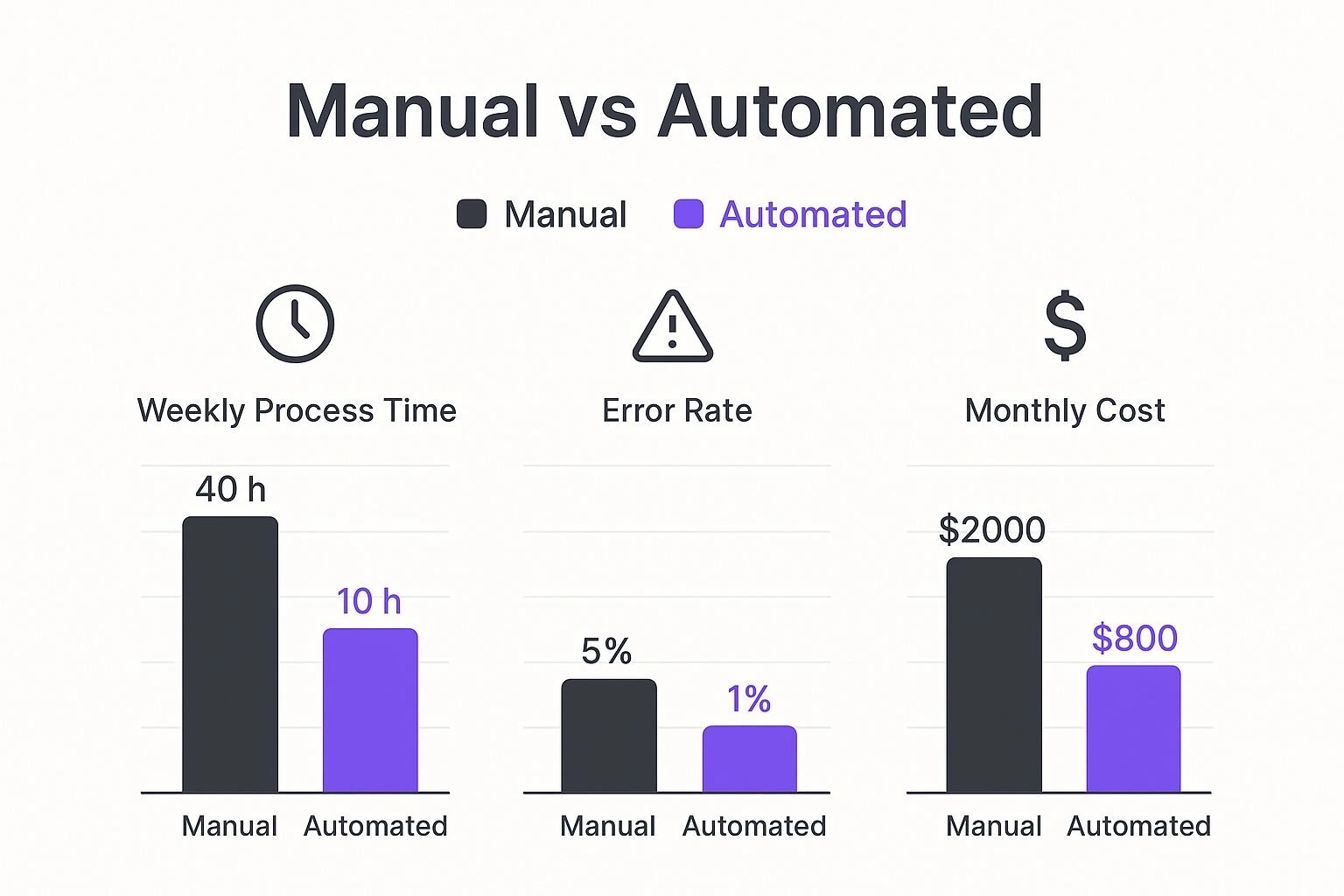Unlocking Efficiency with Business Process Automation
Discover how business process automation transforms operations. This guide covers key strategies, tools, and real-world examples for Australian businesses.

At its heart, business process automation (BPA) is all about using technology to handle the repetitive, rule-based tasks that eat up so much of our time. It’s about setting up smart, automated workflows that run on their own, freeing your team from the grind of manual work.
Think of it like setting up direct debits for your bills. You set the rules once—who to pay, how much, and when—and the system takes care of it reliably every month. You don’t have to think about it again, and you can focus your attention on more important financial planning. BPA applies that same logic to your business operations.
So, What Is Business Process Automation, Really?
It’s easy to get bogged down in the technical jargon, but the idea behind business process automation is surprisingly simple. Picture your business as a complex machine with many moving parts—departments, teams, and individual tasks. BPA is the engine that connects all those parts and makes them run together smoothly and efficiently.
It’s not about replacing people. It’s about empowering them. Instead of an accounts person manually chasing, printing, and shuffling invoices from desk to desk for approval, an automated workflow can route it digitally in seconds. Instead of the HR team manually sending out the same welcome pack to every new employee, a system can trigger and deliver everything the moment a new starter is added to the system.
From Basic Workflows to Smart Systems
Business process automation isn’t a one-size-fits-all solution; it exists on a spectrum. On one end, you have straightforward workflow automation that’s perfect for simple, linear tasks. A great example is an automated email sequence that nurtures a new lead after they’ve downloaded a whitepaper from your website.
On the other, more sophisticated end of the scale is intelligent process automation (IPA). This is where technologies like artificial intelligence (AI) and machine learning come into play, allowing the system to handle complex tasks that normally require human judgment. An IPA system could, for instance, read incoming customer support emails, figure out the customer’s mood and the issue’s urgency, and automatically assign it to the best-equipped support agent.
The real goal of business process automation isn’t just about speed. It’s about building a more reliable, accurate, and scalable foundation for your entire operation. It lets your people step away from monotonous tasks and focus their brainpower on innovation, strategy, and solving genuine problems.
A Growing Focus for Australian Businesses
This isn’t just some passing global fad; BPA is rapidly becoming a core strategy for Australian businesses that want to remain competitive. Our local market is a major player in the booming Asia-Pacific region, with Australia’s investment in BPA software set to continue its strong growth trajectory.
This push is driven by a clear need to modernise operations, reduce overheads, and deliver better customer experiences, especially in a challenging economic climate. With the regional market forecast to grow by more than 60% between 2021 and 2025, it’s obvious that Aussie companies are looking to automation to build stronger, more resilient businesses. You can explore more on the BPA market’s impressive growth on cognitivemarketresearch.com.
Ultimately, business process automation is about creating a smarter organisation from the ground up. It bridges the gaps between different systems, gets rid of tedious data entry, slashes the risk of human error, and gives your team the space to work on the high-value activities that actually move the needle.
The Real-World Gains of Automating Your Processes

While the theory behind business process automation is interesting, its real worth is measured in the concrete results it brings to the table. These aren’t just abstract ideas; they are tangible improvements that show up in your organisation’s performance, influencing everything from the bottom line to team morale.
Instead of just listing generic benefits, let’s look at what this actually means day-to-day. Picture your finance team getting back hours every week because invoice processing and approvals are now handled automatically. This doesn’t just speed up payment cycles; it virtually eliminates the risk of costly human errors in data entry. A single misplaced decimal or an incorrect supplier code can cause major headaches, something automation is designed to prevent.
Or think about a marketing team running a complex campaign. An automated workflow can schedule social media posts across different platforms, send out personalised email sequences, and update customer profiles in your CRM—all without anyone needing to lift a finger. This ensures a perfectly coordinated campaign, freeing up the team to focus on creative strategy instead of just ticking boxes.
Boosting Productivity and Accuracy
One of the first things you’ll notice after implementing business process automation is a major jump in productivity. When you hand over the repetitive, mind-numbing tasks to software, you free up your people to focus on work that truly matters—the kind that requires sharp thinking, problem-solving, and creativity. It’s not about squeezing more out of your team; it’s about letting them work on what they do best.
This naturally leads to much better accuracy. Let’s be honest, manual data entry is a recipe for mistakes. Automation follows the rules you set, every single time, without getting tired or distracted. The result is higher-quality data and more dependable outcomes across the board.
By methodically removing manual touchpoints, business process automation creates a stronger, more resilient operational backbone. It shifts your processes from relying on someone’s memory to a system of standardised, repeatable workflows that are both reliable and easy to audit.
This solid foundation of accuracy and efficiency paves the way for smarter decision-making. When your leadership team has access to real-time, error-free data, they can make strategic calls with far more confidence.
The Financial and Strategic Impact
The financial argument for business process automation is compelling. The benefits start to stack up over time, delivering a strong return on investment through a few key avenues:
- Reduced Operational Costs: Automating tasks that used to take up countless human hours directly cuts down your labour costs for those processes.
- Mitigated Error-Related Expenses: Fewer mistakes mean less time and money spent fixing problems, dealing with unhappy customers, or sorting out compliance issues.
- Increased Scalability: Automated systems can handle a growing workload without needing a proportional increase in staff, helping your business grow more efficiently.
Beyond just smoothing out your core operations, automation can also have a huge impact in more specialised fields, like automating carbon data processes. This shows how automation can support not just financial targets but also wider corporate responsibility goals.
These gains aren’t isolated; they reinforce each other. If you’re just starting out, learning how to automate manual processes is the essential first step toward creating a more agile and competitive business. It’s a strategic investment that prepares your organisation to adapt to market changes and grab new opportunities as they arise.
Choosing Your Automation Toolkit
Picking the right automation approach is a bit like choosing the right vehicle. You wouldn’t take a sports car on a rugged outback track, just as you wouldn’t use a massive truck for a quick trip into the city. Every tool is designed for a specific job, and knowing the difference is the first step toward getting it right.
Not all automation is created equal. The field covers everything from simple bots that follow strict rules to intelligent systems that can make sophisticated judgements. The best choice for your business will come down to the process you need to fix, your budget, and what you’re trying to achieve long-term.
Understanding Robotic Process Automation
On one end of the spectrum, you have Robotic Process Automation (RPA). It’s helpful to think of RPA as a digital workforce that’s brilliant at following clear, step-by-step instructions. These software ‘bots’ interact with your existing applications just like a person would—clicking, typing, copying, and pasting.
RPA is the perfect fit for tasks that are:
- Highly Repetitive: Think of tasks like generating the same weekly report or processing payroll.
- Rule-Based: The process is straightforward, following “if this, then that” logic with few, if any, exceptions.
- Prone to Human Error: Manual data entry from one system to another is a classic example where mistakes can easily happen.
A great real-world example is in accounts payable. An RPA bot can be set up to open an email, find an attached invoice, pull out the invoice number and amount, and then key that data into your accounting software. It does this over and over without getting tired or making typos, freeing up your finance team to focus on more valuable work.
The real power of RPA is its ability to automate processes that involve older, legacy systems without needing complex integrations or APIs. It works right on the user interface, making it a fantastic tool for modernising workflows that are otherwise stuck in the past.
Advancing With Intelligent Process Automation
Taking a big step up in sophistication, we arrive at Intelligent Process Automation (IPA). This is where automation gets a major brain boost from artificial intelligence (AI) and machine learning (ML). While an RPA bot strictly follows rules, an IPA system can learn from data, adapt its actions, and handle tasks that require judgement.
IPA essentially combines the raw power of RPA with smart technologies like:
- Natural Language Processing (NLP): For understanding human language in emails or documents.
- Machine Learning (ML): To spot patterns in data and make informed predictions.
- Optical Character Recognition (OCR): For reading text from scanned documents and images.
Imagine an IPA system managing your customer support inbox. It wouldn’t just file incoming tickets. It would actually read the message, figure out the customer’s sentiment (are they angry or just curious?), categorise the problem, and send it to the best person to handle it. This opens the door to automating much more complex and unstructured business processes.
The following image highlights just how significant the impact of automation can be on key business metrics.

As you can see, making the switch can slash weekly work hours by 75% and cut monthly costs by 60%, all while dramatically reducing the error rate.
Comparing Types of Business Process Automation
To help you decide which technology is the best fit for your needs, this table breaks down the key differences between the common types of automation.
| Automation Type | Primary Use Case | Technology Used | Complexity Level |
|---|---|---|---|
| Robotic Process Automation (RPA) | Automating repetitive, rule-based tasks on existing systems. | Software bots, screen scraping | Low to Medium |
| Intelligent Process Automation (IPA) | Automating complex processes involving unstructured data and decisions. | RPA, AI, Machine Learning, NLP | High |
| No-Code/Low-Code Platforms | Empowering business users to build simple workflows and integrations. | Visual drag-and-drop interfaces | Low |
Each approach offers unique advantages. RPA is excellent for tackling high-volume, predictable tasks, while IPA is built for more dynamic, data-rich environments. No-code platforms, on the other hand, put the power of automation directly into the hands of the people who know the processes best.
Embracing No-Code and Low-Code Platforms
One of the most exciting developments in this space is the explosion of no-code and low-code platforms. These tools give non-technical staff the ability to build and launch their own automated workflows using simple drag-and-drop interfaces.
This “democratisation” of automation is a game-changer. It means solutions can be built and tested much faster, without creating a bottleneck in your IT department. As you build out your automation toolkit, checking out the Top 10 No Code Automation Tools is a great way to see how you can empower teams to solve their own process challenges directly.
Seeing Business Process Automation in Action

It’s one thing to talk about the theoretical perks of automation, but to really get it, you need to see how it solves real-world problems. Let’s move past the concepts and dive into how automation can work within different departments of a typical Australian business.
These examples show the genuine ‘before and after’ of putting automation to work. We’ll look at the specific pain points and see how a targeted solution clears bottlenecks, frees up people’s time, and delivers far better results.
The Finance Team Buried in Invoices
Picture the accounts payable team at a mid-sized logistics firm before automation. They were literally drowning in paper. Invoices would land in an inbox, get printed out, and then physically walked from desk to desk for approvals. It was slow, clunky, and a recipe for mistakes. Invoices got lost, payment deadlines were missed, and the team spent most of its day just chasing things up.
The Transformation:
By bringing in an automated invoice processing system, their entire workflow was redesigned from the ground up. The new software uses optical character recognition (OCR) to lift data straight from incoming invoices, match them to purchase orders, and route them digitally to the right person based on pre-set rules.
- Before: It took an average of 12 business days to process one invoice.
- After: That time plummeted to just 2 business days.
- Outcome: Late payment fees vanished, supplier relationships got a boost, and the finance team could finally put their skills toward strategic financial analysis instead of admin.
This shift gets to the heart of what business process automation is all about. It’s not just about doing the old process faster; it’s about creating a fundamentally better workflow built for efficiency and accuracy, turning a cost centre into a smooth-running asset.
The HR Department Overwhelmed by Onboarding
An expanding tech company was hitting a wall with employee onboarding. Their HR team was struggling to give every new starter a consistent, positive first impression. Manually preparing contracts, organising IT gear, and scheduling induction meetings for each person was a massive time sink, and things fell through the cracks. It was common for important steps to be missed, leaving new employees feeling a bit lost in their first week.
The Transformation:
The company switched to an automated onboarding workflow. Now, as soon as a candidate accepts their offer, the system kicks off a series of perfectly timed actions.
- Contract Generation: The system automatically fills out a standard employment contract with the new hire’s details and sends it off for a digital signature.
- IT Provisioning: It instantly creates a ticket for the IT department to prepare the necessary hardware and software access.
- Welcome Sequence: A pre-written series of welcome emails are scheduled, drip-feeding the new starter key info, team intros, and their first-week agenda.
The change was immediate. Every single new hire received a professional and seamless onboarding experience. This didn’t just get them up to speed faster; it reinforced the company’s image as an organised, modern place to work.
The Operations Manager Bogged Down by Stocktakes
For a national retail chain, keeping tabs on inventory across dozens of stores was a constant headache. The operations manager was stuck using manual stocktakes and massive, complex spreadsheets. This meant they were always playing catch-up, leading to frequent stockouts of popular items while other products gathered dust. With the data always being out of date, any attempt at accurate forecasting was pure guesswork.
The Transformation:
The retailer connected their point-of-sale (POS) systems with an automated inventory management platform. Now, every single sale updates stock levels across the board in real-time. The system is set up to:
- Send automatic reorder alerts when an item’s stock drops below a certain level.
- Analyse sales data to predict future demand and recommend ideal stock levels for each store.
- Automate stock transfers between locations to cover regional shortfalls and balance inventory.
This live, accurate view of their inventory has slashed both stockouts and overstocking, leading to a 15% increase in sales for key product lines. The operations manager now spends their time fine-tuning the supply chain, not counting boxes in a storeroom.
These examples make it clear that automation isn’t some huge, single concept—it’s a flexible tool. For a very practical example, consider a guide on how to use AI to take meeting notes, which shows how even routine tasks can be dramatically improved. By finding those specific, high-friction processes, any organisation can find opportunities to cut down on manual work, reduce errors, and unlock serious value.
Your Roadmap for Implementing Automation
Moving from an idea to a real-world solution needs a solid game plan. A successful automation journey doesn’t start with a massive, all-at-once overhaul. That’s a recipe for disaster. Instead, it begins with a focused, methodical approach that delivers tangible results quickly, building momentum for bigger changes down the track.
This roadmap lays out a structured path for introducing automation without causing chaos. Following these steps helps make sure your first efforts are a success, showing clear value to the business and encouraging your team to embrace smarter ways of working. A clear plan is non-negotiable, and you can get a more detailed breakdown in our guide on how to create an automation roadmap for your organisation.
Step 1: Identify the Right Processes
Your first step is the most important: pick the right target. Not every process is a good candidate for automation, especially when you’re just starting out. You need to look for tasks with specific traits that make them perfect for a first project.
You’re hunting for the “low-hanging fruit”—those processes that are:
- High-Volume and Repetitive: Think of tasks that happen over and over, following the same script each time. Things like processing standard invoices or generating weekly sales reports are perfect examples.
- Rule-Based: The decisions are simple and based on clear logic. If you can map it out with “if this, then that” steps, it’s a great candidate.
- Prone to Human Error: Manual data entry or copying information between different programs are classic culprits. These are areas where small mistakes can become big problems.
- Time-Consuming but Low-Value: We all have them—the jobs that eat up hours of someone’s day but don’t really move the needle on strategic goals.
Choosing a process that ticks these boxes sets you up for an undeniable win. Steer clear of complex workflows full of exceptions for your first go.
Step 2: Select the Appropriate Tools
Once you have a process in mind, you can find the right technology to match. The key here is to fit the tool to the task, not the other way around. A common mistake is buying a huge, complex platform to solve a simple problem.
Think about what you actually need. Could a straightforward workflow tool like Zapier connect your apps and solve the problem? Or do you need the power of a Robotic Process Automation (RPA) bot to interact with an old, clunky system? Start with a tool that solves the immediate problem without adding unnecessary cost or complexity.
Focus on a solution that gives you a clear return on investment for this specific pilot project. The goal is to prove the concept works, not to build the perfect, all-in-one system from day one.
Step 3: Launch a Pilot Project and Measure Success
This is where the rubber hits the road. A pilot project is just a small-scale, controlled test of your automation idea. Its purpose is to confirm your thinking, iron out any wrinkles, and—most importantly—deliver real, measurable benefits.
Talk to the team involved and be crystal clear. Frame this automation as a tool to help them, not replace them. Show them how it will free them from boring, repetitive work so they can focus on more interesting and valuable activities.
To prove the project was a success, you have to track the right metrics. You need to know your starting point, so measure everything before you flick the switch.
Key Metrics to Track:
- Process Cycle Time: How long does the task take from start to finish?
- Cost Per Transaction: What’s the labour cost before and after automation?
- Error Rate: What percentage of outputs needed to be fixed by a person?
- Employee Time Reclaimed: How many hours have been given back to the team for higher-value work?
With this data, you can build a powerful business case, proving the ROI and getting the buy-in you need to tackle your next automation project.
Automating with Confidence and Compliance
Bringing process automation into your organisation can unlock some incredible efficiencies. But here in Australia, that power comes with some serious responsibilities. True innovation isn’t just about speed; it’s about building your automation strategy on a solid foundation of legal compliance and ethical practice. That’s how you earn—and keep—customer trust.
For any Australian business, the first step is getting your head around the legal landscape. As soon as your automation touches personal information, it must be in lockstep with our national frameworks. This isn’t just a friendly suggestion; it’s a legal requirement that shields both your customers and your business from significant risk.
Navigating Australian Legal Frameworks
At the heart of your compliance efforts are a few key pieces of legislation. Any Digital Process Automation (DPA) project has to strictly follow regulations like the Privacy Act 1988 and the guidelines set out by the Office of the Australian Information Commissioner (OAIC). For those in finance or other specified sectors, the Consumer Data Right (CDR) framework introduces another critical layer of rules governing data handling.
The Australian companies that really nail automation bake compliance right into their systems from day one. This means putting essential safeguards in place, like role-based access controls to restrict who can view sensitive data, robust data encryption to protect information in transit and at rest, and crystal-clear audit trails for every automated decision. These aren’t just features; they’re fundamental to innovating responsibly.
Beyond simply ticking legal boxes, ethical automation is about upholding the Australian values of fairness and transparency. It’s a commitment to ensuring technology serves human judgment rather than blindly replacing it—a principle that builds lasting trust with your customers.
Beyond the Law: The Ethics of Automation
Compliance is the floor, not the ceiling. To truly excel with business process automation, you need to turn your attention to ethics. This means actively working to prevent your automated systems from producing unfair or biased outcomes.
One of the most effective ethical guardrails you can install is a ‘human-in-the-loop’ system. This approach simply means that a real person reviews and signs off on critical automated decisions, like a loan application approval or a complex customer service issue. It provides a vital check against machine error and ensures that important context is never lost.
Another huge ethical consideration is tackling algorithmic bias. If you train an AI model on historical data that contains old biases, the model will just learn and amplify them in its decisions. Proactively running bias detection audits on your AI-driven workflows is absolutely essential for ensuring fairness.
Ultimately, the goal is to build a culture of responsible automation. While the technical details are crucial, exploring the various business process automation benefits reveals that the biggest wins happen when technology empowers people and reinforces trust. By pairing legal diligence with ethical oversight, you can automate with the confidence that you’re building a stronger, more reputable organisation.
Frequently Asked Questions About BPA

It’s only natural to have a few questions when you start digging into business process automation. Getting clear, straightforward answers is the first step to making a smart decision for your business. Let’s tackle some of the most common questions we hear from Australian businesses just like yours.
Will Business Process Automation Replace Our Employees?
This is probably the biggest question on everyone’s mind, and it’s an important one. The honest answer is that BPA is designed to augment your team, not replace them. It’s all about taking over the monotonous, rule-driven tasks that bog people down.
Think of it less as a replacement and more as a super-efficient assistant for your staff. By automating things like manual data entry or repetitive report generation, you free your people to focus on what they do best: solving complex problems, innovating, and building meaningful customer relationships. In many cases, it even creates new, more strategic roles centred on managing and optimising these new automated workflows.
Is BPA Only for Large Corporations?
That might have been true a decade ago, but not anymore. While the big players were definitely the first to jump on board, today’s automation technology is incredibly accessible and affordable, making it a genuine game-changer for small and medium-sized enterprises (SMEs).
Modern platforms are often cloud-based with flexible subscription models, which means you don’t need a massive upfront investment in hardware or software. For an SME, automating a few key processes like invoicing or customer onboarding can give you the operational muscle to compete with much larger organisations. It levels the playing field.
The real measure of ROI for business process automation isn’t just about cutting costs. It’s a combination of financial savings from reduced manual labour and fewer errors, plus the immense strategic value gained from improved staff morale, faster service, and stronger compliance.
How Do We Measure the ROI of Automation?
Thinking about the return on investment for BPA requires looking beyond simple cost-cutting. A proper analysis weighs up both the hard financial data and the softer, but equally important, strategic benefits.
To get a full picture, you need to consider a few different angles:
- Quantitative ROI: This is the easy part. You can directly track the money saved from reduced labour hours and the financial impact of fewer errors. Faster turnaround times often translate directly into revenue.
- Qualitative ROI: This involves looking at things like employee morale—are people happier and more engaged now that the grunt work is gone? You can also measure things like customer satisfaction scores, which almost always improve with faster, more accurate service.
- Strategic ROI: This is about the long game. Think about improved compliance, your newfound ability to scale quickly without hiring an army, and the creative energy your team can now pour into growth and innovation.
Ultimately, a true ROI calculation is a blend of all three. It’s the combination of immediate financial wins and the powerful, long-term advantages that really show the value of automation.
Ready to stop wasting time on repetitive tasks and start focusing on growth? At Osher Digital, we specialise in creating automation solutions customised to your business, unlocking efficiency and driving real results. Discover how we can help you scale at osher.com.au.
Jump to a section
Ready to streamline your operations?
Get in touch for a free consultation to see how we can streamline your operations and increase your productivity.